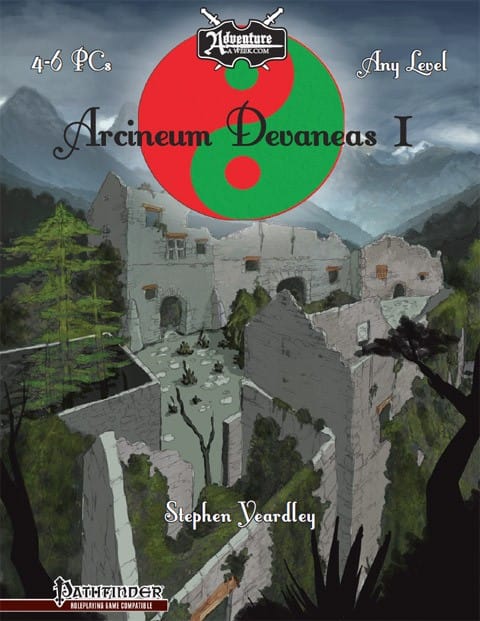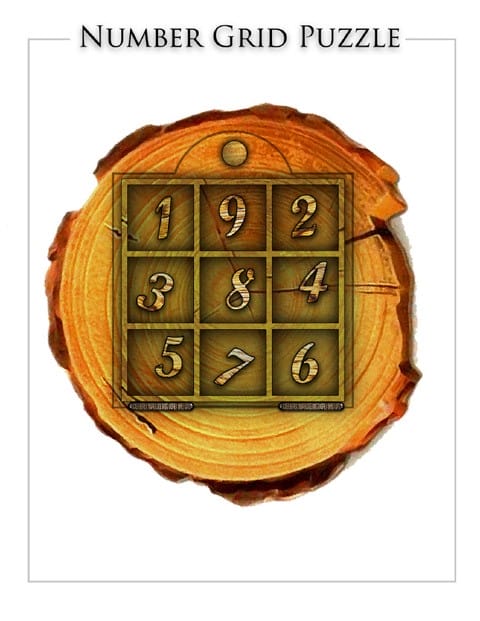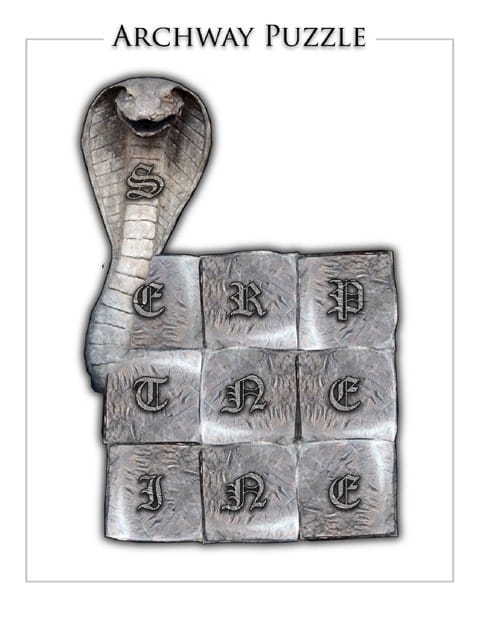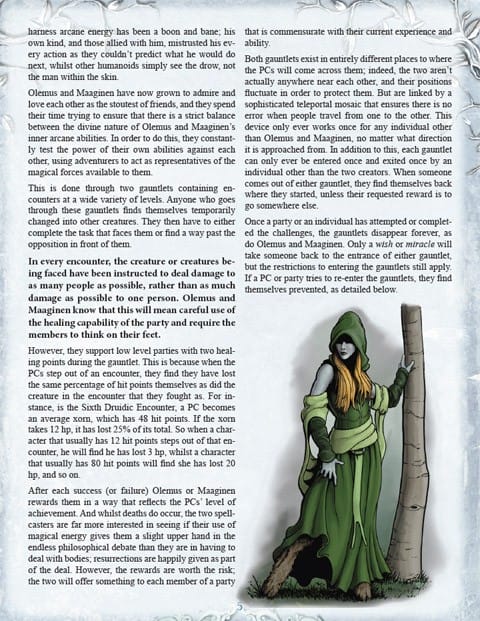| Format | |
|---|---|
| Level | 1, 2, 3, 4, 5, 6, 7, 8, 9, 10, 11, 12, 13, 14, 15, 16, 17, 18, 19, 20 |
| Author |
Dire, Devilish Deeds (1 of 4): Arcineum Devaneas 1
By Stephen Yeardley
A Pathfinder/3.5 Compatible Adventure for 3-6 PCs of Any Level
Magic weaves its way through everyone’s life, whether they realize it or not. Its energy flows all around them, from the simplest cantrip or orison all the way to the mightiest spells that shake worlds. But the one thing that seems stronger than magic itself is the disagreement between those that wield as to whether divine or arcane energies hold sway; this argument has continued since the birth of the gods!
So when two friends, both successfully powerful beyond the dreams of most mortals, decide to spend a few centuries answering this very question, something very special has to be at work. And the testing gauntlets set up by Olemus Multa and Maaginen Jekku are indeed special; ingenuity, cunning, bravery and sharp wits are all required to find a way through these mind-bending passageways, with encounters designed to establish just who does hold the upper hand.
Of course, doing these two spellcasters such a big favor leads to great rewards, so long as the place isn’t broken into pieces during events. A party will find that the rewards reflect the PCs’ level of achievement, as well as turning up after the failure of others. And whilst deaths do occur, the two spellcasters are far more interested in seeing if their use of magical energy gives them a slight upper hand in the endless philosophical debate than they are in having to deal with bodies; resurrections are happily given as part of the deal. Eventually, at the end of each gauntlet, the players will find that the rewards are worth the risk; the two will offer something to each member of a party that is commensurate with their current experience and ability, and is “just what the caster ordered”.
So if you can find these mystery settings, rumored to be on a plane following a path through the universe, hop on board and try your luck. Really, what have you got to lose!
Part 1 of the Dire, Devilish Deeds quartet contains:
- A plane-spanning environment that is far from what it seems
- The first 8 encounter areas of this challenging gauntlet
- Puzzles to test the skills of both the players and the PCs, with progress and rewards influenced by their degree of success
- Traps with “helpful” results
- New creature, the “Tree of Planes”, which allows access to many and varied places across the multiverse
- Chances to face combat at a variety of levels, in a variety of ways, as a variety of creatures
- The opportunity for your PCs to take place in the greatest experiment known to humanoidkind and to influence the results!
$6.99
1 review for Dire, Devilish Deeds (1 of 4): Arcineum Devaneas 1
This site uses Akismet to reduce spam. Learn how your comment data is processed.























Thilo Graf (verified owner) –
An Endzeitgeist.com review
This first installment of the Dire Devilish Deeds-saga clocks in at 37 pages, 1 page front cover, 1 page editorial, 1 page ToC, 1 page SRD, 1 page back cover, leaving us with 32 pages of content, so let’s take a look!
Now this reviews discusses a module and thus does sport SPOILERS. Potential players should jump to the conclusion.
…
..
.
Still here? Only DMs left?
All right, this module’s theme, in the immortal words of Monty Python’s flying circus, would be “And now for something completely different.” So this module is uncommon in more than one way – first of all, it is for “any level.” If you’re like me, you’ll be thinking “WTF, how is this supposed to work out?” – well, to explain that, I have to discuss the basic premise of this saga. Ever wondered what demigod-powerful adventurers might do once they survive a campaign, kill their foes, etc.? Well, in the case of Olemus Multa and Maaginen Jekku, a drow sorceror and a svirfneblin druid of nigh unprecedented power, the answer is “to engage in philosophical banter on the supremacy of divine or arcane magic.” To settle their friendly dispute, they extend (concealing their nature to avoid racial prejudice) a kind of “invitation” to the party – whether via strange shops, aromatic teas or the like, the PCs are drawn into the dispute of the two powerful adventurers. The two individuals have set up demiplane-like gauntlets to test the wits and power of adventurers, with the first one herein being a forest-like maze. Now here’s the cincher, though – the PCs won’t be fighting in their usual forms, at least, for the most part – archways and the very nature of this gauntlet will transform them into various shapes and e.g. pit them in colobus monkey form versus fiendish dire rats. And yes, that stats are provided.
Now if you’re like me, you’ll be skeptical here – after all, death thus can become a pretty possible thing; however, the adventurers do not aim to kill people; they can, and will, return dead PCs back to life and word of recall etc. all help making this not an exercise in frustration, even though the enforced polymorphing may rub some players the wrong way. If you manage to get over this initial trepidation, though, the angle of the saga remains a very fresh one. It should also be noted that this transformation is complete – with the notable exception of still allowing for communication between the PCs, it does not allow for magic items, spells, etc. and thus deviates from how such magic usually works – thus breaking essentially how polymorph spells work. So yes, your PCs are stuck in the stats of the creatures they transform into. Reversal does carry over HP and suggests a percentile representation – took 30% damage? So did your regular body. I’m not a fan of this, since it is more time-consuming than it ought to be, but handwaving this shouldn’t be too difficult for the DM either. While my first impulse is to complain about that and yes, if you are particular about that, be warned of it, but here, I won’t complain. Because this module is pretty much NOT about the combat challenges.
What do I mean by this? Well, this is pretty much closer to Quest for Glory or King’s Quest than to similar RPGs. This is essentially a point-and-click-adventure as a module – complete with puzzles. Yes, puzzles – and interesting ones. The first is pretty simple: A floorboard with gems, wherein no gem should cross lines with another one. If this sounds opaque, rest assured that a visual representation of the challenge, also coming with a solution for the DM, makes the puzzle pretty apparent. Now the benefits reaped from its completion help getting the party through the deadly gauntlet.
The second puzzle also has an awesome visual representation – the letter “S” carved into the head of a stone snake, its body leading down to the next letter of the word “serpentine” – now the PCs need to deduce in how many continuous ways the word can be spelled via this contraption. Again, a gorgeous visual representation helps here and provides an edge for the polymorph challenge ahead – transformation into black bears versus lemures.
The next test provides a grid with 5 skull-fields that represent undead foes. 5 noble warriors seek to vanquish them – alas, the undead detect too much life force concentrated on one field. Thus, the tokens for the warriors need to be placed on the field, their steps on their way to the individual undead they are sworn to destroy traced…and all of that without any warrior crossing each other’s path. And the PCs SHOULD definitely defeat this puzzle, for the polymorph challenge puts them in the bodies of apes and pits them against HELLHOUNDS. Yeah, without the puzzle’s boon, they will require lady luck on their side…
The final puzzle depicted herein would be a field of numbers, ranging from 1 to 9, carved into a tree stump. They need to be arranged in such a way as to make the number in the second row twice that in the first and that in the bottom row three times that in the top row. Now if this puzzle looks impossible at first, one needs to be careful in re-examining the wording here – it does work. And yes, once again we have visual representation of the puzzle and its solutions For the solution, they receive the most benefits so far – and they’ll need them – for the final challenge sees them face fiendish giant wasps in the scaly hides of a deinonychus. Each challenge, btw., nets a wooden letter that is part of the final puzzle, the way to leave the gauntlet, which is depicted in Arcineum Devaneas II.
The pdf comes with a gorgeous map of the gauntlet, including a player-friendly version.
Conclusion:
Editing and formatting are very good, I noticed no significant glitches. Layout adheres to a beautiful full-color two-column standard and the pdf comes fully bookmarked for your convenience and with ample gorgeous artworks.
Okay, this module will not be for everyone. And it imho requires Part II for a basic conclusion. But know what? I ADORE THIS MODULE.
If you’re like me, you’ve run A LOT of modules, read even more. I’ve NEVER run a module like this. In the beginning, I said that this was more like “Quest for Glory” than regular modules and there’s a reason for this – beyond the ample puzzles provided, each combat essentially is a puzzle. They can be won by brute force and luck, yes, but in the end, the fights require more brains than brawns – this is no “optimize to win”-scenario, it is one that tests the mental prowess of your players. Better yet, the module does not penalize failure in admittedly stacked environments and does not require the completion of the puzzles herein. Their visual handouts render running them very easy and the combat itself is neat as well.
The premise of the narrative set up is fresh as well and what could be considered “shoehorned” actually works superbly thanks to the diverse hooks – one is bound to work for just about any group. Still, one thing remains – the module *does* somewhat cheat – the polymorph-effects work pretty much in non-standard ways here and the rules-rationale for HP-carry-over etc. is clunky at best, the deviation from how polymorph works is jarring – in this regards, the module is far from perfect and requires that you accept the premise.
Now Stephen Yeardley’s “Dire, Devilish Deeds” requires an open mind, yes, but it is more fresh wind in design, premise and execution than I’ve seen in ages. And its unique set-up also means that the instances in which the rules are bent are not there to arbitrarily create difficulty or shoehorn one room/hazard to work (something I LOATHE) or worse, penalize characters by randomly stripping away powers. The change in rules instead exists to propel the narrative and make the basic premise of this array of challenges work – it’s not a cop-out, it’s a narrative enabler for something that would not have worked in the default frame. Without this change, the whole set-up, the whole story, would not work. If this kind of thing does bug you, please detract a star from my final rating.
If this saga can maintain the level of awesomeness exhibited herein, we’ll have an instant classic on our hands. The first module elicited a sense of jamais-vu from me and turned out to be a thoroughly tantalizing trip. This is superb and captivating and while the premise sports some rough edges, if you tackle it as it’s intended to, I guarantee that you will not have ever played something like this. This module is a breath of fresh air, a glorious example for the versatility of our system and a rebuke to the claims that only a limited number of playstyles or module-types work within a given system. I adore this module. It is well worth a final verdict of 5 stars + seal of approval and. Now the series imho requires owning at least 2 modules, unless you want to scavenge the puzzles/polymorph challenges, so I’m going to hold off for now regarding declaring this as a candidate for my Top Ten of 2015, but if the other parts hold up, this is exactly what I consider them to be.
If you’ve been feeling the “been there, done that”-blues, if you want a change of pace, if you want to reward innovation and if you enjoy challenging the smarts of your players, then this should be considered a must-buy module – get it. We need more modules that dare to deviate from the tired old formulas.
Endzeitgeist out.